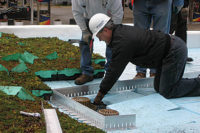Rooftops: White or Black?




There’s been much discussion about roof color since the roofing industry has been part of the conversation about energy efficiency and sustainable roof systems. National attention was focused on this topic when former Secretary of Energy Stephen Chu made the statement that all rooftops should be painted white.
It bears consideration why Secretary Chu made that statement. Was his comment building focused or environment focused? I strongly believe his statement was rooted in climate change issues, and not necessarily in building-specific energy issues.
It’s true dark surfaces absorb more heat energy than light-colored surfaces, but what we really should say is that urbanization and the built environment are changing the surface characteristics of the earth. Dark-colored roofs, parking lots, and roadways create areas of increased temperature, both large and small. When it’s hot and sunny, a light grey concrete sidewalk is more comfortable to stand on than an asphalt parking lot. So it’s not really appropriate to single out rooftops as the one and only flat surface that is changing the temperature of the earth’s surface.
Let’s take a closer look at the issue of roof color. There are a number of ways to break down the discussion. Does building proportion matter — that is, the percentage of roof area relative to the entire building envelope? Does geography/climate matter when it comes to roof color — the often-debated North-versus-South issue? Does the amount of insulation in an existing or new roof system matter? All of these matter very much.
The roof on a tall, slender high-rise makes little or no difference to the overall energy efficiency of the building. Does roof color matter on the Willis Tower (aka, the Sears Tower)? No; however, a white roof on a one-story big box store in a predominately cooling climate will definitely help reduce the cooling loads. But what about the one-story big box store in a heating climate? Reducing heat gain in this building will increase the need to heat the building, and doesn’t that contradict energy efficiency and our attempts to mitigate climate change?
Much of the “all roofs should be white” discussion originated in California, where the climate is mostly warm, and it occurred during the time when only small amounts of insulation were used. And many roofs in California still have very little insulation. With that in mind, changing roof color from dark to light on a building located in a cooling climate that has little roof insulation makes sense. But that doesn’t translate to all geographic locations, building types and roof systems with large variations of insulation.
Here’s an analogy to consider. When it’s hot outside, do you wear a black T-shirt or a white T-shirt? White, because it makes you feel cooler. The white reflects heat, and the shirt provides little insulation. Contrarily, when it’s cold outside, do you worry about the color of your jacket or the thermal resistance of the jacket? When it’s cold, insulation trumps surface color.
I believe Chu was speaking about climate change when he said, “Paint all roofs white.” And that’s not a bad idea if the only consideration is climate, or if it’s determined the roof really has little or no affect on overall building efficiency. Default to white when roof color doesn’t affect energy efficiency of a building.
It’s a complicated issue, and there’s plenty more to discuss, but I propose we get back to thinking about the basics of building science. Let’s start thinking about buildings as if there was no air conditioning or heating. What color roof would make the building most comfortable to use? It certainly depends on location (geography and climate), building proportions and the amount of insulation in the roof system. If that’s how we start the roof color discussion, then the answers should come easily.
Looking for a reprint of this article?
From high-res PDFs to custom plaques, order your copy today!








